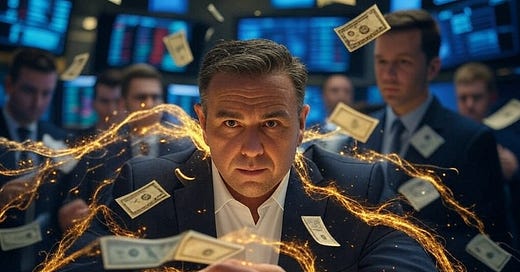Dear Reader,
I got a text earlier: "You seeing this rally? After that April bloodbath? Thought we were headed for the cliff!"
I laughed.
If you'd told me a month ago that the S&P would be trading where it is today after what President Trump dubbed "Liberation Day" and Wall Street's "Tariff Tantrum," I'd have called you crazy.
But here we are. April went from market catastrophe to one of the biggest rebounds since World War II.
The S&P 500 surged 9.5% in a single session on April 9th when Trump paused most of his sweeping tariffs - just days after the index had plummeted below 5,000 for the first time in a year.
Know who got crushed the hardest? Everyone.
Those wild swings sent the CBOE Volatility Index above 50 – a rare level we haven't seen since last August's Carry Trade scare. When markets collapse or spike that dramatically, nobody makes money except the lucky few who perfectly timed their move.
This chaos reminded me of my early days on the Chicago trading floors in the 2000s.
Back then, market intelligence came through your ears as much as your eyes. You could literally hear momentum building across the massive trading floor.
The sudden roar from a distant pit meant something big was happening.
That's when I first learned about "floaters" - not the bond kind. These were savvy traders who wouldn't get married to a single position or pit. They'd drift around the floor, following the sound and energy of the action.
If they heard commotion from the soybean pit, they'd float on over. Maybe they'd jump in, maybe they'd just observe and walk away. "Not what I thought it was," they'd mutter, moving on to the next opportunity.
These floaters never got trapped. While specialists stayed put in their assigned pits through thick and thin, floaters had freedom. They could catch unexpected momentum across different markets while avoiding dead zones.
Here's the secret most people miss: great traders become great investors using the same mindset. The skills transfer perfectly. Both require you to stay nimble, avoid emotional attachment to positions, and adapt when conditions change.
In April 2025, we saw exactly why being a floater matters. The market tumbled deeply into the red after Trump unveiled hefty global tariffs. Then it staged a historic rally when he paused most of them. Then it dropped again when the White House clarified the plan for a massive 145% tariff on China.
The specialists - those locked into a single strategy or sector - got slaughtered.
Meanwhile, traders who could float between defensive positions and growth opportunities thrived in the chaos.
Here's what I've learned: Don't be the guy who can't leave his pit when the action moves elsewhere. Markets reward those who can drift toward opportunity and away from danger.
Tomorrow's market won't look like today's. Your best edge isn't prediction - it's adaptation.
So here's your one action for today: Review your portfolio and honestly ask yourself how "stuck" you are. Could you pivot quickly if conditions change? Or are you so committed to one sector, strategy or narrative that you'd be paralyzed by another "Tariff Tantrum"?
The best traders I know are comfortable being uncomfortable. They don't need to be right all the time - they just need the freedom to float when they're wrong.
Trade smart. Until tomorrow,
Josh "Floater" Belanger





Josh, the 'unusual' trade signal is indeed a way to follow someone who may know something the rest of us don't . It would be an eye opener, and a nice carrot for me to join your paid service, if you would keep an eye on those unusually large trades (usually out of the money) and review them once in a while...:) Cheers, Nick